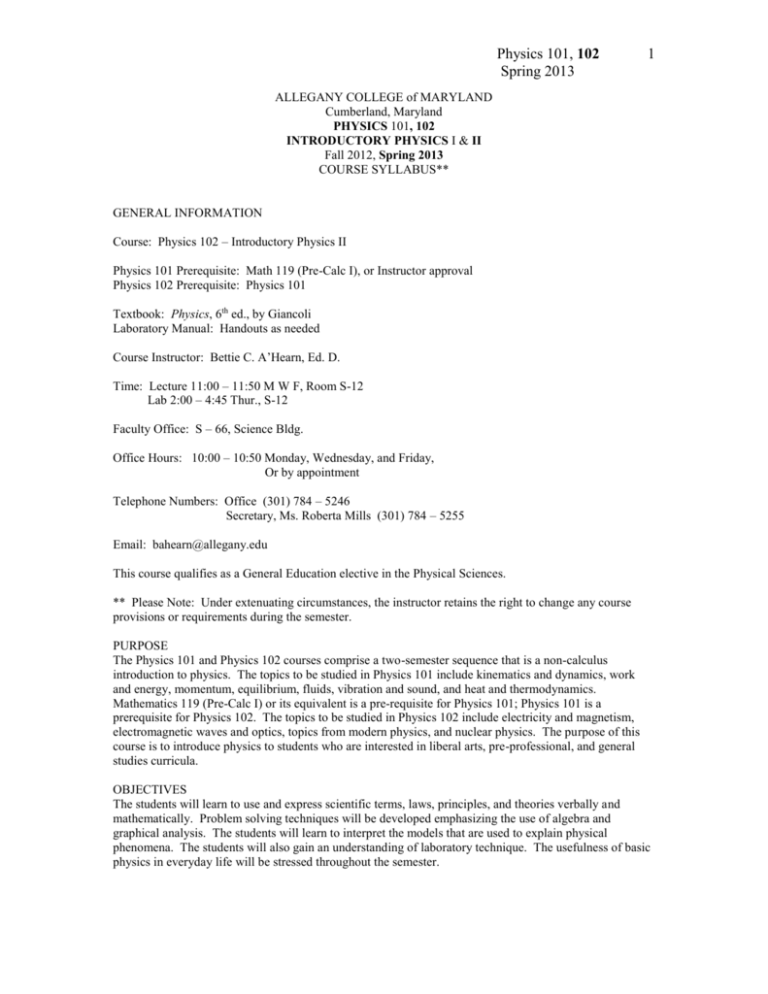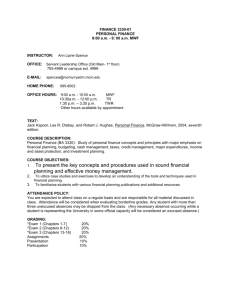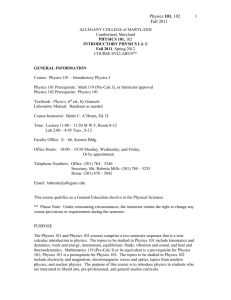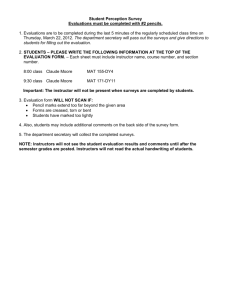ALLEGANY COLLEGE of MARYLAND
advertisement

Physics 101, 102 Spring 2013 1 ALLEGANY COLLEGE of MARYLAND Cumberland, Maryland PHYSICS 101, 102 INTRODUCTORY PHYSICS I & II Fall 2012, Spring 2013 COURSE SYLLABUS** GENERAL INFORMATION Course: Physics 102 – Introductory Physics II Physics 101 Prerequisite: Math 119 (Pre-Calc I), or Instructor approval Physics 102 Prerequisite: Physics 101 Textbook: Physics, 6th ed., by Giancoli Laboratory Manual: Handouts as needed Course Instructor: Bettie C. A’Hearn, Ed. D. Time: Lecture 11:00 – 11:50 M W F, Room S-12 Lab 2:00 – 4:45 Thur., S-12 Faculty Office: S – 66, Science Bldg. Office Hours: 10:00 – 10:50 Monday, Wednesday, and Friday, Or by appointment Telephone Numbers: Office (301) 784 – 5246 Secretary, Ms. Roberta Mills (301) 784 – 5255 Email: bahearn@allegany.edu This course qualifies as a General Education elective in the Physical Sciences. ** Please Note: Under extenuating circumstances, the instructor retains the right to change any course provisions or requirements during the semester. PURPOSE The Physics 101 and Physics 102 courses comprise a two-semester sequence that is a non-calculus introduction to physics. The topics to be studied in Physics 101 include kinematics and dynamics, work and energy, momentum, equilibrium, fluids, vibration and sound, and heat and thermodynamics. Mathematics 119 (Pre-Calc I) or its equivalent is a pre-requisite for Physics 101; Physics 101 is a prerequisite for Physics 102. The topics to be studied in Physics 102 include electricity and magnetism, electromagnetic waves and optics, topics from modern physics, and nuclear physics. The purpose of this course is to introduce physics to students who are interested in liberal arts, pre-professional, and general studies curricula. OBJECTIVES The students will learn to use and express scientific terms, laws, principles, and theories verbally and mathematically. Problem solving techniques will be developed emphasizing the use of algebra and graphical analysis. The students will learn to interpret the models that are used to explain physical phenomena. The students will also gain an understanding of laboratory technique. The usefulness of basic physics in everyday life will be stressed throughout the semester. Physics 101, 102 Spring 2013 2 COURSE POLICIES (In addition to the following course policies, college policies stated in the Student Handbook regarding academic standards and student conduct apply.) ATTENDANCE Students are expected to attend all lecture and laboratory sessions. Each unexcused absence may reduce the final course grade. It is helpful if the student can notify the instructor that he or she will be absent that class period. If the number of absences is such that the instructor believes that the student cannot successfully complete the course in the time remaining, the instructor may drop that student from the class roster. If the student is dropped after the midpoint of the course, a grade of “F” will be recorded. If the student has registered in an audit status, a grade of “W” will be recorded. PARTICIPATION Students are expected to read all assignments in advance and be able to take part in class discussions. Class participation is encouraged and students should feel free to ask questions during the lecture or lab. The students should try to apply their new knowledge to everyday happenings in order to make physics more meaningful to them. STUDENT EVALUATION The final grade for the course will be computed on the following basis: Hour Exam Average…………………40% Homework……………………………20% Laboratory Exercises…………………20% Lab Practical Exam…………………… 5% Cumulative Final Exam………………15% There will be three or four scheduled hour exams each semester. The lowest exam score may be replaced by the final exam score, if the final exam score is better. All hour exam scores will count equally toward the hour exam average. Homework will be assigned weekly, with selected problems and assignments turned in for credit. There will be a variety of laboratory exercises. Each exercise will be graded and count toward the total laboratory score. A laboratory practical exam will be given near the end of the semester; students will be allowed to use graded laboratory exercises as a reference during the practical exam. The final exam is cumulative in nature. The students will be allowed to use a formula sheet during all hour exams and the cumulative final exam. Grading Scale: A= B= C= D= F= 90.0 – 100 79.0 – 89.9 68.0 – 78.9 57.0 – 67.9 56.9 and below EXTRA CREDIT Generally, there is no opportunity for extra credit in this course. TUTORING, EXTRA HELP SESSIONS The instructor will assist the students in obtaining tutoring services. This may be initiated by either the instructor or by the student. Students who desire to be tutored should go to the Coordinator of the Student Success Center in the Humanities Building, Rooms H-58 to make arrangements. Special review sessions and recitation periods may be arranged when either the instructor or the students feel that they would be helpful. Physics 101, 102 Spring 2013 3 COMPLETION OF ASSIGNMENTS Assignments must be turned in on time as announced either in class or on the syllabus. Generally, no late work will be accepted unless there are extenuating circumstances. An “X” grade will be given only, when in the opinion of the instructor, the student fails to satisfactorily complete all assignments due to circumstances beyond the control of the student. FORM OF ASSIGNMENTS All work turned in to be graded must be neat and legible or it will not be graded. Problem assignments may be done in pencil. Laboratory reports should be done using computer technology. Any written assignments must include citations for all sources. All exams may be done in pencil. MAKEUP OF MISSED EXAMS The student is required to take all exams. The student is required to make arrangements for making up a missed exam upon returning from an excused absence. CHEATING AND/OR PLAGIARISM Cheating, in any form, will not be tolerated in this course. Copying someone else’s laboratory report or homework is included as a form of cheating. Students observed or otherwise determined to be cheating will be dealt with severely and immediately, according to the Policy Regarding Student Cheating, as stated in the Student Handbook. LABORATORY SAFETY AND BREAKAGE Expectant mothers should confer with their physicians prior to engaging in the laboratory phase of this course. Safety glasses may be required during some of the exercises. Students are required to immediately report all accidents to the instructor, regardless of how minor they may seem. Students are required to pay for all damages done to laboratory equipment and materials. ACCOMODATING DISABILITIES In compliance with federal 504/ADA requirements, Allegany College of Maryland supports the belief that all “otherwise qualified” citizens should have access to higher education and that individuals should not be excluded from this pursuit solely by reason of handicap. The college is committed to the integration of students with disabilities into all areas of college life. Therefore, support services are intended to maximize the independence and participation of disabled students. Further, the College complies with applicable state and federal laws and regulations prohibiting discrimination in the admission and treatment of students. Any student who has a disability should contact the Director of Learning Support and Disability Services at 301-784-5112, TDD 301-784-5001, jbracken@allegany.edu or http://www.allegany.edu/ssc/disabledstudentservices.shtml to obtain information and assistance. Physics 101, 102 Spring 2013 PHYSICS 102 TENTATIVE LECTURE SCHEDULE Week Topic 1 Temperature, Kinetic Theory, Heat Chapters 13, 14 2 Heat and Laws of Thermodynamics Chapters 14, 15 3 Laws of Thermodynamics 4 Electric Charge and Field Chapter 16 5 Electric Potential Chapter 17 6 Electric Currents and DC Circuits Chapters 18, 19 7 DC Circuits, Magnetism Chapters 19, 20 8 Electromagnetic Induction, EM Waves Chapters 21, 22 9 Geometric Optics Chapter 23 10 Wave Nature of Light Chapter 24 11 Special Theory of Relativity Chapter 26 12 Early Quantum Theory, Atomic Models Chapter 27 13 Quantum Mechanics of Atoms Chapter 28 14 Molecules and Solids Chapter 29 15 Nuclear Physics, Radioactivity Chapter 30 * Physics, 6th ed., Giancoli Reading Assignments* Chapter 15 4 Physics 101, 102 Spring 2013 PHYSICS 102 TENTATIVE LABORATORY AND EXAM SCHEDULE DATE TOPIC Jan 24 Ideal Gas Laws Jan 31 Heats of Fusion and Vaporization Feb 7 Electric Field Mapping Feb 14 Exam I Feb 21 Oscilloscope, RC Circuit Feb 28 Oscilloscope, Semiconductors Mar 7 DC Circuits, Meters Mar 14 Exam II Mar 21 RLC Circuits Mar 28 Spring Break Apr 4 Geometric Optics Apr 11 Physical Optics Apr 18 Exam III Apr 25 Easter Break May 2 Lab Practical Exam May 9 Comprehensive Final Exam 5





